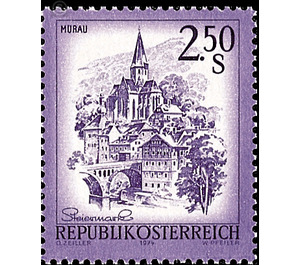landscapes - Austria / II. Republic of Austria 1974 - 2.50 Shilling
Theme: Geology & Geography
| Country | Austria / II. Republic of Austria |
| Issue Date | 1974 |
| Face Value | 2.50 |
| Color | violet |
| Printing Type | combination printing |
| Stamp Type | Definitive |
| Item Type | Stamp |
| Chronological Issue Number | 784 |
| Chronological Chapter | OOS-OE2 |
| SID | 849058 |
| In 155 Wishlists | |
The brand image shows Murau in Styria. For the area around the present city a settlement can be proven since the early Bronze Age. Romans and Slavs also left their mark. However, the most striking, and preserved to date, was not set until the middle of the 13th century with the construction of the castle Murau by Ulrich von Liechtenstein. At the same time as the Burg Murau, a first settlement in the form of a street market was built at the foot of the castle hill around today's Raffaltplatz, which was inhabited mainly by chivalrous followers of the Liechtensteiners. Jews also settled here. During the interregnum, the castle Murau as a barrier fortress against the archdiocese of Salzburg was very important. Located at the intersection of several transport routes, Murau not only had strategic and political significance, but was also important in the late Middle Ages as a bridge, toll, low-loader and transshipment point. Among the goods traded here, especially iron and salt stand out. Murau was at that time a center of iron trade in Europe. Valuable insights into the history of the city can be found in the city book, which has been preserved since 1424 and is one of the oldest of its kind. The Murauer do not rely on industry or trade for the survival of the city, but one tries to transform the whole district Murau into a versatile recreational area.


